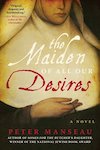A woman disappears, “taken by wind.” A one-eyed priest frantically carves a feminine-looking crucifix for an abbey chapel, hoping it will absolve his sins. A group of nuns hides a text of mystical sayings by an elderly nun living a solitary existence in a remote cave, one of which warns the sisters not to trust “the works of men.” Medieval nuns squabble and pray, build and tear down, and battle both the surging plague and their own histories in Peter Manseau’s new novel The Maiden of All Our Desires.
For centuries, abbeys and monasteries were more than just houses of prayer. They were also places where women, freed from the tethers of motherhood and arranged marriages, were able to live independently, to write their own rules of life, and to create communities which mostly escaped the prying eyes of authority figures. Behind cloister walls, revolutionary women thinkers like Hildegard Von Bingen, Julian of Norwich, Sor Juana Ines De La Cruz and many others were able write their own scripts for life in a time when most women were condemned to illiteracy.Manseau’s Gaerdegen Abbey is fictional, but clearly based on actual monasteries in Medieval Europe. The plague stalks everyone in the book in one way or another, its presence rippling through the span of decades. Divided into sections marking the Liturgy of the Hours, the ancient sets of prayers that mark the days of monastic life, time becomes another thematic link, as characters’ backstories unfold against the inner drama of the monastery and the outer drama of survival.
Mother John, the abbess, is “filled with nostalgia for a time that never was,” and it’s clear that she and many of the other nuns weren’t drawn to the abbey by the inescapable gravity of religious vocation: they came out of necessity. Medieval women who wanted to avoid forced birth or a lifetime of violence from a father or husband had very few options outside of the church or death. When other abbeys became homes to the spoiled daughters of the wealthy, ascetic nuns formed more austere communities like Gaerdegen. But no matter who lived there, these communities were still places of refuge for women trying to escape from men.
The problem for the women of Gaerdegen is that every community of women needs a priest, and that priest has to be a man—still does, in fact. Father Francis, the book’s tormented and egocentric priest, provides a horror show of disgusting penances for sinning nuns—along with his own backstory—that helps remind the reader that even some of these privileged sons of the church would rather have been just about anywhere else. The son of artisan carvers, Father Francis lives on the monastery grounds in a tiny hut, embittered and paranoid, and convinced that the nuns’ prayers may be a waste, because for him, when it comes to the plague, “mysticism will not protect us.”
But the book’s most compelling character spends much of the story behind the scenes and off the page. Mother Ursula, the community’s mystical, ancient foundress, left the community when they chose to build a wall around the abbey. She spends most of the book in a remote cave communing with birds and sending scraps of prayer to the nuns, which later become the fictional Book of Ursula and the subject of an investigation by the local bishop for possible heresy. For the nuns, who “drank scripture in all day and relished the chance to spit it out transformed,” the words of Ursula provide a contrast to the masculine language of the daily office.
Ursula’s esoteric evocations of finding God in nature and choosing to call God ‘She’ are also a callback to another Medieval solitary who, like Ursula, was a religious provocateur, the English mystic Julian of Norwich. Julian referred to both God and Christ as “our true Mother” and advised her readers to “pray fervently to our mother.” As the author of the first book in English written by a woman, Julian also mirrors Ursula’s scrawls of prayer.
It is Mother Ursula who’s there at the end of the book, helping bring together the intertwining narrative arcs, silently sitting in her cave unaffected by the plague, seemingly as ancient as God herself. Manseau’s skill in this novel isn’t only to make characters who could easily have fallen into holy cliché feel like real, breathing humans, unlike many saints. As a prolific writer about religion and the curator of American Religious History at the Smithsonian Institution, he also brings a scholarly background to the novel, though not one that muffles or dampens the story or his characters. History, here, breathes like the wind that blows throughout the chapters.



